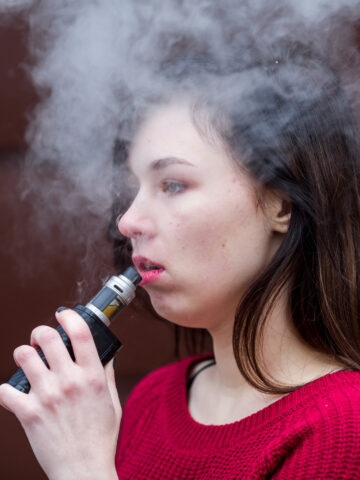By Fionna Lam and Tran Nguyen, clinical pharmacists at CHOC and Dr. Jonathan Auth, CHOC pediatrician
With the winter season nearing the end and spring season already here, many of us are experiencing nasal symptoms related to the common cold, a sinus infection, or seasonal allergies. Since all these conditions share overlapping signs such as sneezing, nasal discharge and congestion, distinguishing between them may be the first step to selecting the proper over-the-counter remedy for symptomatic relief.
The common cold usually peaks during cold weather and is caused by a viral infection. While children may feel crummy for a few days, most cold symptoms can be managed with over-the-counter medications. Sinus infections, on the other hand, can bring about headaches and facial pain. It can happen after a prolonged common cold when the body is more vulnerable to bacterial or viral infections. Some children may be more susceptible to sinus infections than others due to structural abnormalities in the nose.
Sneezing, nasal congestion, and/or watery eyes are the hallmark symptoms of seasonal allergies. These are due to the body’s immunologic reaction to irritants in the air. This condition usually peaks during spring time when the highest amount of pollens from trees, grasses or weeds are present in the environment. Other common allergens include dust and mold.
The following table compares some common signs and symptoms of common cold, sinus infections and seasonal allergies:
| Symptom | Common Cold | Sinus Infection | Seasonal Allergies |
|---|---|---|---|
| Fever/chills | +/- * | +/- | |
| Sneezing | + | +/- | + |
| Stuffy/runny nose | + | + | + |
| Color/consistency of sinus discharge | Clear and watery, or thick and colored | Thick, yellowish or greenish | Clear and watery |
| Sore/itchy throat | + | +/- | |
| Cough | + | ** | +/-** |
| Chest congestion | + | ||
| Headache/facial pain | + | ||
| Stiff neck | + | ||
| Watery eyes | + |
+ present
+/- may or may not be present
*Fever and/or chills are more common in children than adults
**Cough may present if post nasal drip present
It’s important to be aware of how long each symptom has been present. Cold symptoms usually start to show improvement in most children in 7-10 days. Sinus infections usually have longer lasting symptoms without treatment, around 10-14 days. Allergies are usually present for weeks or more.
When an infection or allergy occurs, the blood vessels in your child’s sinuses dilate and the tissues tend to swell up, which can lead to pain around the eyes, cheeks and forehead. Mucus production increases during an infection and can cause further discomfort. Small microscopic hairs in our nose called cilia help sweep bacteria and particles from our nose, but when dry air enters our nose, it can damage the cilia by drying them out.
Before resorting to medications, non-pharmacological strategies can be tried first such as introducing moist air with a humidifier, taking warm showers or drinking hot fluids like tea and soup. Keeping the air moist will help prevent drying out the nose passage and prevent mucus buildup. Applying a warm compress to the face may also help alleviate congestion pain.
A variety of over-the-counter medications can provide targeted symptomatic relief. See the chart below for active ingredients and their role in cold and sinus infections. Learn what to look for when choosing the right over-the-counter medication for your child. While combination products offer the convenience of addressing many symptoms at once, they often contain more than one ingredient. When multiple over-the-counter remedies are taken together, the risk of toxicity increases due to duplication of active ingredients or doubling up on drugs in the same drug class. For example, acetaminophen (Tylenol) is commonly found in many over-the-counter cold and cough medications. Inadvertent overdoses have occurred when parents gave these medications along with Tylenol. To minimize this risk, single ingredient products are recommended whenever possible.
Remember that over-the counter medications are not completely safe and do come with risk of side effects and toxicity if not taken correctly. Talk to your child’s pediatrician or pharmacist before starting a medication regimen.
| Active ingredient | Purpose | Symptoms Treated | |||||
|---|---|---|---|---|---|---|---|
| Mucous | Cough | Pain | Fever | Runny Nose | Stuffy Nose | ||
| Acetaminophen | Pain reliever | + | + | ||||
| Ibuprofen, Naproxen | Pain reliever | + | + | ||||
| Phenylephrine*, Pseudoephrine* | To relieve nasal congestion | + | + | ||||
| Dextromethorphan** | Cough suppressant | + | |||||
| Guaifenesin | To loosen up phlegm | + | + | ||||
| Saline spray | To relieve nasal congestion | + | + | ||||
| Mentholated topical ointment | To relieve nasal congestion | + | + | ||||
| Fluticasone, Triamcinolone (Nasal Spray) | To relieve nasal congestion | + | + | ||||
| Oxymetazoline*, Phenylephrine*(Nasal Spray) | To relieve nasal congestion | + | + | ||||
+ present
*Do not use decongestant for more than 3 days as it might make you more congested.
**Discretion should be used when using dextromethorphan as a cough suppressant as high doses can cause hallucinogenic effects and be abused.






